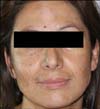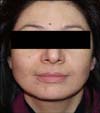Dear Editor:
Platelet-rich plasma (PRP) treatment is performed via the autologous injection of high concentration of platelets in a small volume of plasma1.
A 27-year-old woman presented at our dermato-cosmetology department for skin rejuvenation, as she had epidermal hyperpigmentation over the cheeks, perioral region, and forehead for about 5 years. PRP treatment was initiated and her face was injected with autologous PRP prepared by using RegenKit® (Regen Lab., Le Montsur-Lausanne, Switzerland). Before the treatment sessions, 8 ml of blood was collected from the patient into a special tube containing a separation gel and an anticoagulant. The tube was then centrifuged for 8 minutes at 3,500 rpm, and PRP was obtained from the upper part of the buffy coat. A 32-G needle was used for superficial microinjections via the mesotherapy technique, and the injections were administered in to the papillary dermis (1.5~2.0 mm deep). Approximately 1.5 ml of PRP was injected in to the dermis of the face at each session with 15-day intervals. At the end of the third session of PRP treatment, >80% reduction in epidermal hyperpigmentation was observed (Fig. 1, 2). We did not provide any other treatment or post treatment care besides prescribing the use of a sun-screen product. There has been no recurrence of melasma for 6 months now.
PRP is commonly used in dermatology and plastic surgery, especially for treating chronic wounds, ulcers, and burns. In recent years, PRP has also started to be used in the field of cosmetology1. Volumetric filling, skin rejuvenation, acne scars, and alopecia are the main targets of PRP application in cosmetology1.
The most important contents of platelets are contained in the α-granules. There are >30 bioactive substances in these granules2. Some of the bioactive substances present in the α-granules include platelet-derived growth factor (PDGF), transforming growth factor (TGF)-β1, 2, epidermal growth factor, and mitogenic growth factors such as platelet-derived angiogenesis factor and fibrinogen3. To our knowledge, only TGF-β1 has been investigated about its relation with melanogenesis.
Kim et al.4 investigated the effects of TGF-β1 on melanogenesis by using a spontaneously immortalized mouse melanocyte cell line, and asserted that TGF-β1 significantly inhibits melanin synthesis in a concentration-dependent manner. They declared that TGF-β1 decreases melanogenesis via delayed extracellular signal-regulated kinase activation.
The pigmentary improvement that occurs with PRP treatment may be associated with the increase in skin volume. PDGF has a significant role in blood vessel formation and in the synthesis of collagen and components of the extracellular matrix, including hyaluronic acid. Hyaluronic acid has been shown to increase skin tone and volume, resulting in providing a more 'glowing skin'5.
Although, it is not possible to reach a definitive conclusion, we consider the regression of melasma after PRP treatment as an interesting finding. Controlled clinical trials are needed to confirm this preliminary observation.
Figures and Tables
References
1. Kim DH, Je YJ, Kim CD, Lee YH, Seo YJ, Lee JH, et al. Can platelet-rich plasma be used for skin rejuvenation? Evaluation of effects of platelet-rich plasma on human dermal fibroblast. Ann Dermatol. 2011; 23:424–431.

2. Eppley BL, Pietrzak WS, Blanton M. Platelet-rich plasma: a review of biology and applications in plastic surgery. Plast Reconstr Surg. 2006; 118:147e–159e.

3. Smyth SS, McEver RP, Weyrich AS, Morrell CN, Hoffman MR, Arepally GM, et al. 2009 Platelet Colloquium Participants. Platelet functions beyond hemostasis. J Thromb Haemost. 2009; 7:1759–1766.





 PDF
PDF ePub
ePub Citation
Citation Print
Print




 XML Download
XML Download